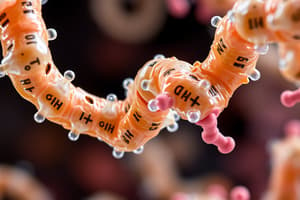Podcast
Questions and Answers
What is a major advantage of immobilizing enzymes over stabilizing them through solvent stabilization?
What is a major advantage of immobilizing enzymes over stabilizing them through solvent stabilization?
- Immobilized enzymes are more expensive to produce
- Immobilized enzymes can be reused or used continuously (correct)
- Immobilized enzymes have lower enzymatic activity
- Immobilized enzymes are more susceptible to denaturation
Which of the following immobilization methods involves the formation of covalent bonds between the enzyme molecules?
Which of the following immobilization methods involves the formation of covalent bonds between the enzyme molecules?
- Adsorption
- Cross-linking (correct)
- Covalent binding
- Entrapment
What is a major disadvantage of solvent stabilization methods?
What is a major disadvantage of solvent stabilization methods?
- They can cause enzyme denaturation
- They can only be used for certain enzymes
- The enzymes remain soluble and cannot be reused (correct)
- They can be expensive
What type of ions have been found to stabilize the tertiary structure of proteases and α-amylases?
What type of ions have been found to stabilize the tertiary structure of proteases and α-amylases?
Which immobilization method involves the physical adsorption of enzyme protein on the surface of water-insoluble carriers?
Which immobilization method involves the physical adsorption of enzyme protein on the surface of water-insoluble carriers?
What is the most common reagent used for cross-linking?
What is the most common reagent used for cross-linking?
What occurs to enzymes when solvents are used at high concentrations?
What occurs to enzymes when solvents are used at high concentrations?
What is a method of enzyme stabilization that involves adding a substrate?
What is a method of enzyme stabilization that involves adding a substrate?
What is a type of enzyme stabilization that involves forming a covalent bond between the enzyme and a support material?
What is a type of enzyme stabilization that involves forming a covalent bond between the enzyme and a support material?
What happens to an enzyme when it is denatured?
What happens to an enzyme when it is denatured?
What is the term for the process of attaching an enzyme to a support material to increase its stability?
What is the term for the process of attaching an enzyme to a support material to increase its stability?
What is a method of enzyme stabilization that involves adding a cation?
What is a method of enzyme stabilization that involves adding a cation?
What is the main disadvantage of using alkanes in the production of SCP?
What is the main disadvantage of using alkanes in the production of SCP?
What is a characteristic of microbial insecticides?
What is a characteristic of microbial insecticides?
What is the function of biofertilizers?
What is the function of biofertilizers?
What type of insecticides are Bacillus thuringiensis and Bacillus popilliae?
What type of insecticides are Bacillus thuringiensis and Bacillus popilliae?
What is the name of the toxin produced by Bacillus thuringiensis?
What is the name of the toxin produced by Bacillus thuringiensis?
What type of relationship do microorganisms in biofertilizers establish with plants?
What type of relationship do microorganisms in biofertilizers establish with plants?
Flashcards are hidden until you start studying





